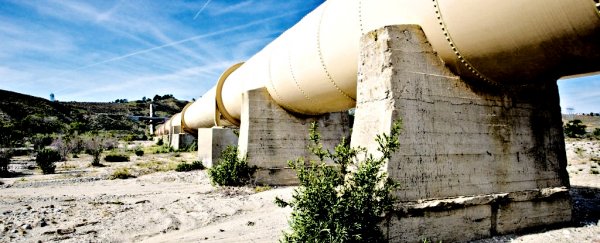Approximately 383,000 gallons of crude oil have spilled into a North Dakota wetland this week in the latest leak from the Keystone Pipeline, further fueling long-standing opposition to plans for the pipeline network's extension.
With about half an Olympic swimming pool's worth of oil covering roughly half an acre, the leak is among the largest in the state, said Karl Rockeman, who directs the North Dakota Department of Environmental Quality's division of water quality.
But the spill does not appear to pose an immediate threat to public health, he added, as people do not live nearby and the wetland is not a source of drinking water.
For environmental groups, though, the leak was further evidence that Canada-based pipeline owner TC Energy should not be allowed to build the controversial Keystone XL addition, which would stretch more than 1,000 miles from Alberta into the United States.
The Trump administration approved the plan in 2017 after years of protests, but the project was blocked by a federal judge who called for further study on environmental impacts.
"With each one of these major spills that happens on the Keystone pipeline system, it becomes clearer and clearer that this is not safe," said Doug Hayes, an attorney leading the Sierra Club's work on Keystone XL.
Critics worry about a similar mishap contaminating one of the hundreds of waterways along Keystone XL's expected path, he said.
TC Energy spokeswoman Sara Rabern said the safety of the public and the environment is the company's "top priority."
"We will take the learnings from this incident, like we do with anytime we have any incident, and use them to improve our pipeline integrity," she wrote in an email, adding that TC Energy spends "millions of dollars each year to ensure we operate [a] safe pipeline system."
This week's leak was Keystone's second big one in two years. Many smaller spills have plagued the pipeline since it opened in 2010 to carry oil from Alberta to Texas.
That's cause for concern, some experts say.
"It's a valid question, two cracks on a fairly new pipeline — geez, what's going on?" Richard Kuprewicz, the president of pipeline safety consulting company Accufacts, told the Star Tribune in Minneapolis.
Asked if regulators are concerned by the multiple incidents, Rockeman said authorities need to learn more about the latest leak's cause, which is still under investigation, according to TC Energy and state authorities.
The federal Pipeline and Hazardous Materials Safety Administration is leading the inquiry and is already on site, Rockeman said.
It could take years for the wetland to return to its normal state, he added.
The leak occurred Tuesday, about three miles from the town of Edinburg, not far from the Canadian border, the state Department of Environmental Quality said.
It's one of the 10 largest onshore oil spills in the country since 2010, when an Enbridge pipeline released more than 800,000 gallons of oil in Michigan, according to the Star Tribune.
No injuries or impacts on animals have been reported, TC Energy said in a statement, adding that the oil is now contained.
Crews are still focused on recovering the oil and will shift later to fixing the pipeline, according to the company. Large stretches of Keystone have been shut down.
Exactly how much was released will not be clear until it's all recovered, TC Energy said. The total for the Keystone pipeline's 2017 gush onto South Dakota agricultural land ended up being revised significantly, from about 210,000 gallons to more than 400,000.
The 2017 spill was probably rooted in a crack caused by a vehicle during Keystone's construction, the National Transportation Safety Board found. The crack likely grew over time, the board concluded.
Revelations of another rupture came as the State Department accepts comments on an environmental review of the hotly debated Keystone XL plan. The department's public meeting about the review, held Tuesday in Montana, broke into shouting at times, the Associated Press reported.
"Yes, there's a risk of an oil spill," said one man whose farm is in the pipeline's path and whom TC Energy is paying for property access, according to the Associated Press. "We have to be willing to take a risk. It's a very minuscule chance."
Montana state Sen. Frank Smith (D) countered that the oil line would eventually break and could jeopardize drinking water. "Obama did a really thorough investigation and decided it wouldn't work," he said, according to the Associated Press.
Environmental advocates have made similar arguments in the wake of the spill near Edinburg.
"We've always said it's not a question of whether a pipeline will spill, but when, and once again TC Energy has made our case for us," Sierra Club associate director Catherine Collentine said in a statement.
2019 © The Washington Post
This article was originally published by The Washington Post.
